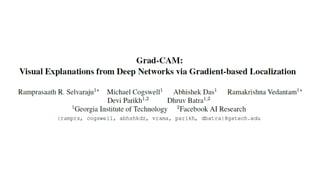Grad-CAM: Visual Explanations from Deep Networks via Gradient-based Localization
•
0 likes•82 views
Grad-CAM: Visual Explanations from Deep Networks via Gradient-based Localization
Report
Share
Report
Share
Download to read offline

Recommended
Recommended
More Related Content
More from Sungchul Kim
More from Sungchul Kim (15)
Generalized Intersection over Union: A Metric and A Loss for Bounding Box Reg...

Generalized Intersection over Union: A Metric and A Loss for Bounding Box Reg...
On the Variance of the Adaptive Learning Rate and Beyond

On the Variance of the Adaptive Learning Rate and Beyond
A Benchmark for Interpretability Methods in Deep Neural Networks

A Benchmark for Interpretability Methods in Deep Neural Networks
KDGAN: Knowledge Distillation with Generative Adversarial Networks

KDGAN: Knowledge Distillation with Generative Adversarial Networks
Search to Distill: Pearls are Everywhere but not the Eyes

Search to Distill: Pearls are Everywhere but not the Eyes
Bootstrap Your Own Latent: A New Approach to Self-Supervised Learning

Bootstrap Your Own Latent: A New Approach to Self-Supervised Learning
FickleNet: Weakly and Semi-supervised Semantic Image Segmentation using Stoch...

FickleNet: Weakly and Semi-supervised Semantic Image Segmentation using Stoch...
Regularizing Class-wise Predictions via Self-knowledge Distillation

Regularizing Class-wise Predictions via Self-knowledge Distillation
FixMatch: Simplifying Semi-Supervised Learning with Consistency and Confidence

FixMatch: Simplifying Semi-Supervised Learning with Consistency and Confidence
Unsupervised Data Augmentation for Consistency Training

Unsupervised Data Augmentation for Consistency Training
Recently uploaded
Recently uploaded (8)
(독서광) 인간이 초대한 대형 참사 - 대형 참사가 일어날 때까지 사람들은 무엇을 하고 있었는가?

(독서광) 인간이 초대한 대형 참사 - 대형 참사가 일어날 때까지 사람들은 무엇을 하고 있었는가?
실험 설계의 평가 방법: Custom Design을 중심으로 반응인자 최적화 및 Criteria 해석

실험 설계의 평가 방법: Custom Design을 중심으로 반응인자 최적화 및 Criteria 해석
Grad-CAM: Visual Explanations from Deep Networks via Gradient-based Localization
- 2. Contents 1. Class Activation Map (B. Zhou et al., 2015.) 2. Guided Backpropagation(J. T. Springenberg et al., 2015.) 3. Grad-CAM 2
- 3. Class Activation Map (B. Zhou et al., 2015.) • Global Average Pooling (M. Lin et al., 2014.) • class에 해당하는 weight들로 마지막 conv layer에 weighted sum • 해당 class가 활성화되는 부분을 확인! 3
- 4. Guided Backpropagation (J. T. Springenberg et al., 2015.) • 기존 backpropagation은 forward의 activation 방식을 따름 • deconvnet (M. D. Zeiler et al., 2014.) 은 gradient의 값으로 activation을 적용 • Guided Backpropagation은 backpropagation + deconvnet 4
- 5. Grad-CAM 5
- 6. Grad-CAM - CAM은 GAP(Global Average Pooling)을 사용해야만 하고, 재학습이 필수적임! → gradient를 계산해서 그것으로 weighted sum 6
- 7. Grad-CAM - CAM은 GAP(Global Average Pooling)을 사용해야만 하고, 재학습이 필수적임! → layer가 깊을수록 뚜렷한 효과가 나타남 7
- 8. Grad-CAM - CAM은 GAP(Global Average Pooling)을 사용해야만 하고, 재학습이 필수적임! → gradient에 ReLU를 적용해서 positive값만 사용 8
- 9. Grad-CAM - CAM은 GAP(Global Average Pooling)을 사용해야만 하고, 재학습이 필수적임! → 다양한 task에서 사용 가능 9 Captioning Visual Question Answering (VQA)
- 10. Grad-CAM - Guided Backpropagation과 결합하여 사용 가능 (Guided Grad-CAM) 10
- 11. Grad-CAM - Guided Backpropagation과 결합하여 사용 가능 (Guided Grad-CAM) → 마찬가지로 다양한 task에 적용 가능 11 Captioning Visual Question Answering (VQA)
- 12. Grad-CAM - Guided Backpropagation과 결합하여 사용 가능 (Guided Grad-CAM) → 제대로 예측하지 못하는 부분을 알아내어 문제를 해결할 수 있음! 12
- 13. Reference - R. R. Selvaraju, M. Cogswell, A. Das, R. Vedantam, D. Parikh and D. Batra, “Grad-CAM: Visual Explanations from Deep Networks via Gradient-based Localization”, in ICCV, 2017. - R. R. Selvaraju, A. Das, R. Vedantam, M. Cogswell, D. Parikh and D. Batra, “Grad-CAM: Why did you say that? Visual Explanations from Deep Networks via Gradient- based Localization”, in CORR, abs/1610.02391, 2016. - B. Zhou, A. Khosla, A. Lapedriza, A. Oliva and A. Torralba, “Learning Deep Features for Discriminative Localization”, in CVPR, 2016. - M. Lin, Q. Chen, and S. Yan. “Network in network”, in ICLR, 2014. - J. T. Springenberg, A. Dosovitskiy, T. Brox and M. Riedmiller, “Striving for Simplicity: The All Convolutional Net”, in ICLR, 2015. - M. D. Zeiler and R. Fergus, “Visualizing and understanding convolutional networks”, in ECCV, 2014. 13